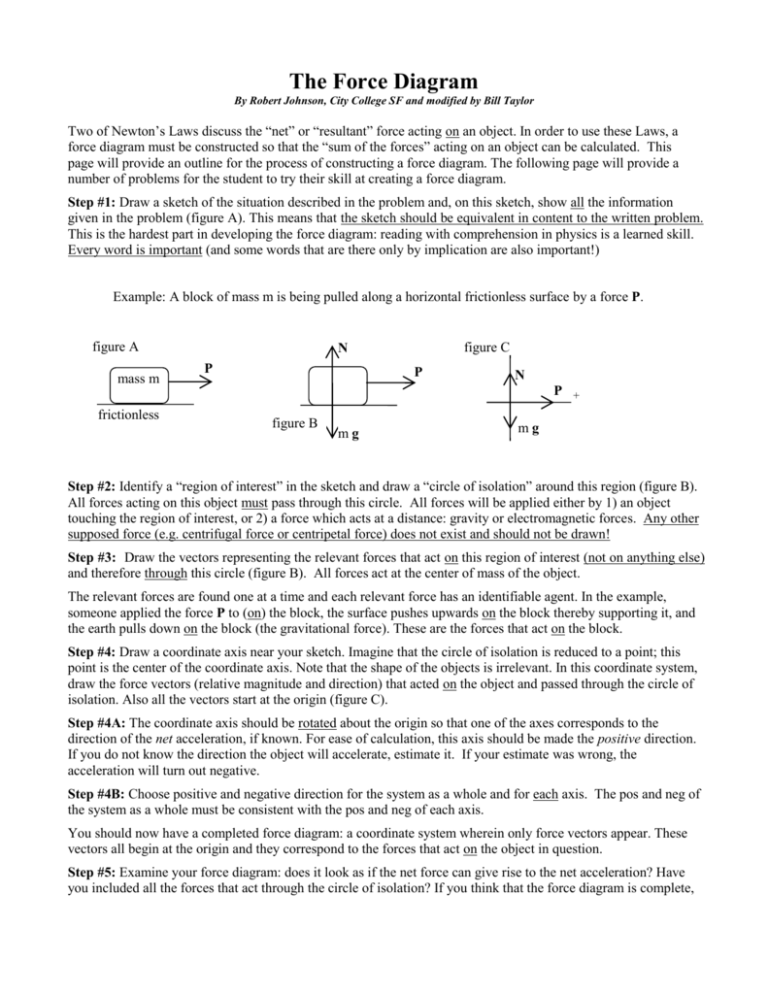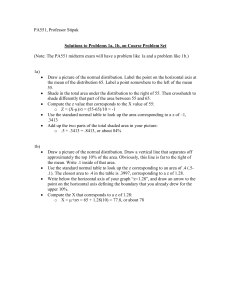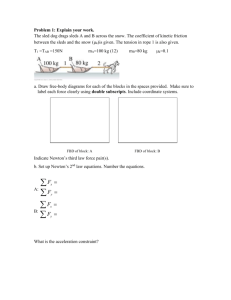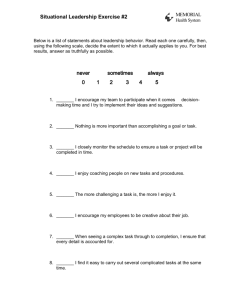The Force Diagram - prettygoodphysics
advertisement

The Force Diagram By Robert Johnson, City College SF and modified by Bill Taylor Two of Newton’s Laws discuss the “net” or “resultant” force acting on an object. In order to use these Laws, a force diagram must be constructed so that the “sum of the forces” acting on an object can be calculated. This page will provide an outline for the process of constructing a force diagram. The following page will provide a number of problems for the student to try their skill at creating a force diagram. Step #1: Draw a sketch of the situation described in the problem and, on this sketch, show all the information given in the problem (figure A). This means that the sketch should be equivalent in content to the written problem. This is the hardest part in developing the force diagram: reading with comprehension in physics is a learned skill. Every word is important (and some words that are there only by implication are also important!) Example: A block of mass m is being pulled along a horizontal frictionless surface by a force P. figure A mass m frictionless figure C N P P N P + figure B mg mg Step #2: Identify a “region of interest” in the sketch and draw a “circle of isolation” around this region (figure B). All forces acting on this object must pass through this circle. All forces will be applied either by 1) an object touching the region of interest, or 2) a force which acts at a distance: gravity or electromagnetic forces. Any other supposed force (e.g. centrifugal force or centripetal force) does not exist and should not be drawn! Step #3: Draw the vectors representing the relevant forces that act on this region of interest (not on anything else) and therefore through this circle (figure B). All forces act at the center of mass of the object. The relevant forces are found one at a time and each relevant force has an identifiable agent. In the example, someone applied the force P to (on) the block, the surface pushes upwards on the block thereby supporting it, and the earth pulls down on the block (the gravitational force). These are the forces that act on the block. Step #4: Draw a coordinate axis near your sketch. Imagine that the circle of isolation is reduced to a point; this point is the center of the coordinate axis. Note that the shape of the objects is irrelevant. In this coordinate system, draw the force vectors (relative magnitude and direction) that acted on the object and passed through the circle of isolation. Also all the vectors start at the origin (figure C). Step #4A: The coordinate axis should be rotated about the origin so that one of the axes corresponds to the direction of the net acceleration, if known. For ease of calculation, this axis should be made the positive direction. If you do not know the direction the object will accelerate, estimate it. If your estimate was wrong, the acceleration will turn out negative. Step #4B: Choose positive and negative direction for the system as a whole and for each axis. The pos and neg of the system as a whole must be consistent with the pos and neg of each axis. You should now have a completed force diagram: a coordinate system wherein only force vectors appear. These vectors all begin at the origin and they correspond to the forces that act on the object in question. Step #5: Examine your force diagram: does it look as if the net force can give rise to the net acceleration? Have you included all the forces that act through the circle of isolation? If you think that the force diagram is complete, then proceed to apply Newton’s equations. If the answer that you calculate seems to be unreasonable, then check your force diagram to see if it is correct. If you are not sure about the description of the system, then assume the simplest situation. Newton’s Law Equations: In keeping with the established guidelines for good practice in solving physics problems, we will express and solve the problem symbolically before entering any numbers we may have. Step 1. All force and motion problems begin with Newton’s Second law: Fnet ma For two-dimensional problems, write a large X with a line under it and a Y with a line under it. Under each line write Fnet , x ma or Fnet , y ma Thus: X Fnet , x ma Y Fnet , y ma Step 2. Now symbolically sum the forces along each axis (no numbers yet). Don’t forget signs, which come from the + and – directions on your Force Diagram. Step 3. Identify and write down any additional equations you can apply to the situation. For example, the one and only one equation which includes µ, or an expression for centripetal acceleration. Step 4. You now have a system of equations. If you are solving symbolically only, make sure your final solution includes only the variables you are allowed to use, and that your solution for a variable doesn’t include that variable in the “answer” expression. If you are solving for a numerical answer, now is a good time to think about how many variables you have and how may equations you need. If you don’t have enough equations, maybe there is something you missed. Practice Problems: 1. A block of weight W is on a level friction surface. A horizontal force P is applied to the block and it moves with a constant velocity. 2. A block of mass m is on a rough level surface and is pulled by a force P at an angle of 30° wrt the horizontal. 3. A block of weight W is pushed against a rough vertical wall by a force P that is perpendicular to the wall. 4. Two blocks lay on a smooth level surface. They are next to and in contact with one another. A horizontal force P is applied from the left of the system. 5. A block of mass m is on a rough surface that is inclined at an angle . 6. Two blocks, connected by a cord, are on a friction surface that is inclined at an angle to the horizontal. 7. A block of mass m1 is on a level frictionless table and is connected by a light rope passing over a small frictionless pulley to another hanging block of mass m2. 8. Two blocks, on top another, are on a level surface. The bottom block is pushed by a horizontal force P. Situation (a): there is no friction; (b): there is friction between all surfaces. 9. A ball of mass M and a massless string are used to form a simple pendulum that displaces at an angle from the vertical.






